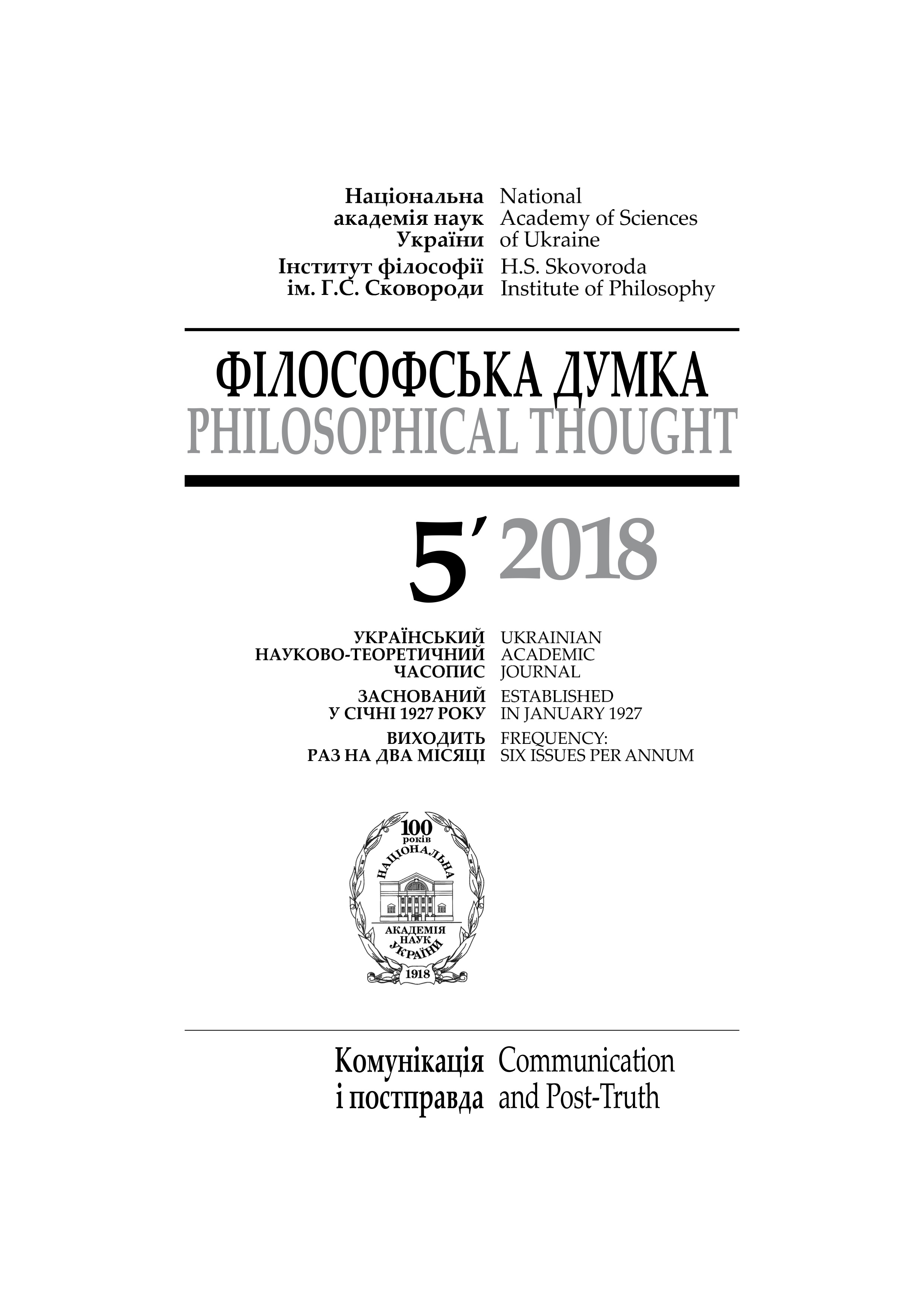Methodological fundamentals of visual theory in the philosophical projects of Maurice Merleau-Ponty and Gilles Deleuze
Keywords:
the body, the sight, experience of the visual, the affectation, the hapticAbstract
This article aims to outline the methodological fundamentals of a presentational approach within a visual theory. Its supporters consider vision not as an act of objectivation but as a special form of contact between an object and a beholder. The article reconstructs philo- sophical foundations of this approach, basing on the vision theories developed by Maurice Merleau-Ponty and Gilles Deleuze. Therefore, the article outlines three primary principles of understanding vision: (1) visual experience cannot be reduced to the language or de- scribed through the language-derived structures; (2) the vision is an integrally corporeal experience that cannot be considered separately from the body itself; (3) the object takes an active part in the act of vision. Based on the works Merleau-Ponty and Deleuze, the ar- ticle offers terminological refinements that help avoid some methodological controversies of the visual theory. In particular, this refers to the reformulation of «visual experience» into «experience of the visual» — in this way we prevent the limitation of the vision to only its optical component.
References
Avetysian, А. (2016). The Map of Visual Studies: the Main Lines of The Research. [In Ukrainian] Hileia: academic bulletin, 112, 241—244. [= Аветисян 2016]
Avetysian, А. (2017a). Husserl’s notion of affectation as a basis of the coneption of the «looking back» (part 2, pp. 132—134). In: Days of science of philosophy faculty — 2017 [report and presentations materials]. [In Ukrainian] Кyiv: Editorial polygraphical center «Kyiv univer-sity». [= Аветисян 2017]
Avetysian, А. (2017b). Cultural and philosophical accentuations of Thomas Mitchell’s visual theory. [In Ukrainian] Filosofia i politolohia v konteksti suchasnoi kultury. Scientific journal. Dnipro: Oles Honchar Dnipro national University, 2 (17), 4—11 [= Аветисян 2017]
Avetysian, А. (2018). Phenomenological Research of Visual Experience: the Look of a Painter (Based on the Works of Maurice Merleau-Ponty). [In Ukrainian] Philocophical thought, 1,
—105. [= Аветисян 2018]
Boehm, G., Mitchell, W.J.T. (2009). Pictorial versus Iconic Turn: Two Letters. Culture, Theory
and Critique, 50(2—3), 103—121.
Deleuze, G. (2002). Francis Bacon. Paris: Seuil.
Elkins, J. (1999). The object stares back. San Diego, CA: Harcourt.
Husserl, E. (2009). Experience and Judgment: Investigations in A Genealogy of Logic. [In Ukrainian]
Kyiv: PPC-2002. [= Гусерль 2009]
Merleau-Ponty, M. (2001). Phenomenology of Perception. [In Ukrainian] Kyiv: Ukrainian Center
of the Spiritual Culture. [= Мерло-Понті 2001]
Merleau-Ponty. M. (2003) The Visible and the Invisible. Followed by Working Notes. [In Uk-
rainian]. Kyiv: Publishing House KM «Academy». [= Мерло-Понті 2003] Merleau-Ponty, M. (1952) Le langage indirect et les voix du silence (pp. 41—82). In: Signes.
Paris: Gallimard.
Merleau-Ponty, M. (1964). L’oeil et l’esprit. Paris: Gallimard.. Retrieved from: http://classiques.
uqac.ca.classiques.merleau_ponty_maurice.oeil_et_esprit.oeil_et_esprit.pdf. Merleau-Ponty, M. (1966). Le doute de C zann. In: Sens et Non-sens (pp. 15-44). Paris: Les ditions Nagel. Retrieved from: http://classiques.uqac.ca.classiques.merleau_ponty_mau-
rice.sens_et_non_sens.sens_et_non_sens.pdf.
Merleau-Ponty, M. (1979). Le Visible et l’Invisible. Notes de travail. sous la direction de C. Lefort.
Paris: Gallimard. Retrieved from: https://monoskop.org.images.c.c6.Merleau_Ponty_
Maurice_Le_Visible_et_L_Invisible_1979_2001.pdf.
Mitchell, W. (1996). What Do Pictures «Really» Want? October, 77, 71.
Mitchell, W. (2005). There Are No Visual Media. Journal of Visual Culture, 4(2), 257—266. Moxey, K. (2008). Visual Studies and the Iconic Turn. Journal of Visual Culture, 7(2), 131—146. Sylvester, D. (1975). The Brutality of Fact: Interviews with Francis Bacon. New York: Pantheon Books.
Downloads
-
PDF (Українська)
Downloads: 228
Published
How to Cite
Issue
Section
License
Authors who publish with this journal agree to the following terms:
- Authors retain copyright and grant the journal right of first publication.
- Authors are able to enter into separate, additional contractual arrangements for the non-exclusive distribution of the journal's published version of the work (e.g., post it to an institutional repository or publish it in a book), with an acknowledgement of its initial publication in this journal.
- Authors are permitted and encouraged to post their work online (e.g., in institutional repositories or on their website) prior to and during the submission process, as it can lead to productive exchanges, as well as earlier and greater citation of published work (See The Effect of Open Access).


